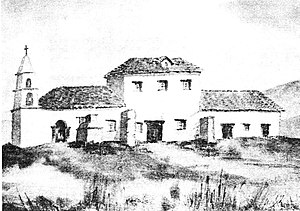Las Flores Asistencia

Las Flores' "San Pedro Chapel" as it appeared around 1850. The structure, along with its adjoining buildings, were constructed in 1823.
|
|
|
Location of Las Flores Estancia in California
|
|
| Location | near San Clemente, California |
|---|---|
| Coordinates | 33°17′59.81″N 117°27′39.85″W / 33.2999472°N 117.4610694°WCoordinates: 33°17′59.81″N 117°27′39.85″W / 33.2999472°N 117.4610694°W |
| Name as founded | Estancia de la Misión de San Luis, Rey de Francia |
| English translation | Station of the Mission San Luis Rey de Francia |
| Patron | Saint Peter, the Apostle |
| Founding date | 1823 |
| Founding priest(s) | Father Antonio Peyrí |
| Military district | First |
|
Native tribe(s) Spanish name(s) |
Payomkawichum-Luiseño + Acagchemem-Juaneño |
| Native place name(s) | Huis'ne |
| Governing body | United States Government |
| Current use | Boy Scout Camp |
| Designated | November 24, 1968 |
| Reference no. | 68000021 |
| Designated | November 24, 1968 |
| Reference no. | #616 |
The Las Flores Estancia (also known as Las Flores Asistencia) was established in 1823 as an estancia ("station"). It was part of the Spanish missions, asistencias, and estancias system in Las Californias—Alta California. Las Flores Estancia was situated approximately halfway between Mission San Luis Rey de Francia and Mission San Juan Capistrano. It is located near Bell Canyon on the Camp Pendleton Marine Corps Base ten miles south of the City of San Clemente in northern San Diego County, California.
The first recorded baptisms in upper Las Californias took place on July 22, 1769 on the banks of a nearby stream, dubbed Los Cristianos by the Spanish soldiers who accompanied the missionaries northward during the "Portolà expedition." Today, the site (referred to more commonly as La Cañada de los Bautismos, literally "The Gorge of the Baptisms," or simply Los Christianitos, "The Little Christians") located at 33°25′41.58″N 117°36′34.92″W / 33.4282167°N 117.6097000°W is designated as California Historical Landmark.
Known at one time as the "San Pedro Rancho," the property featured a tile-roofed chapel (visita) and a hostel, both built by relocated Luiseño and Juaneño Native Americans, the latter for the use of traveling clergy. The buildings formed three sides of a square, 142 feet by 153 feet, all roofed with tile. A portion of the south wing had a second story, and the campanile (bell tower) was utilized as a navigational aid by early sailing ships. The chapel was visited by residents of two nearby Native American villages, Chumella and Questmille. Mission San Luis Rey was raising sheep at Las Flores as early as 1810. To sustain the installation barley, maize, and wheat, were grown and cattle were grazed at nearby Las Pulgas ("the fleas"); also notable was the production of hides and tallow.
...
Wikipedia

